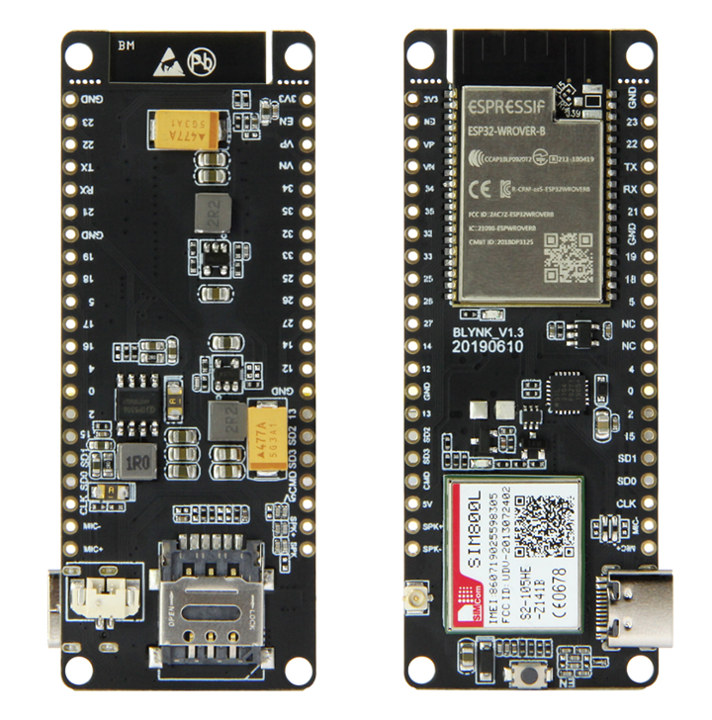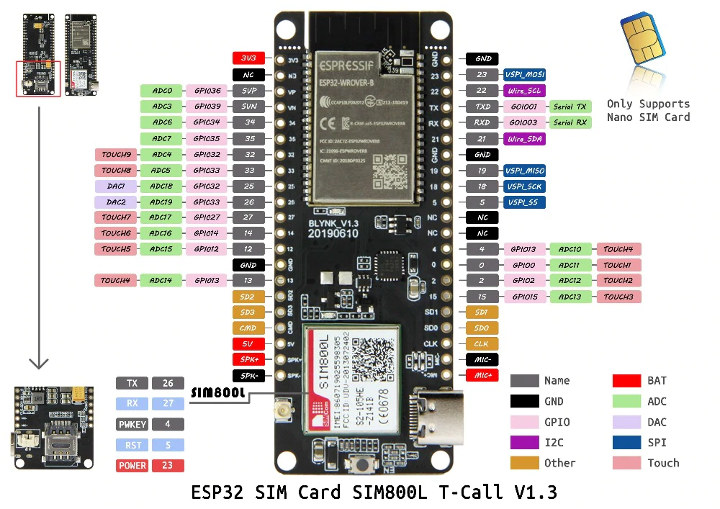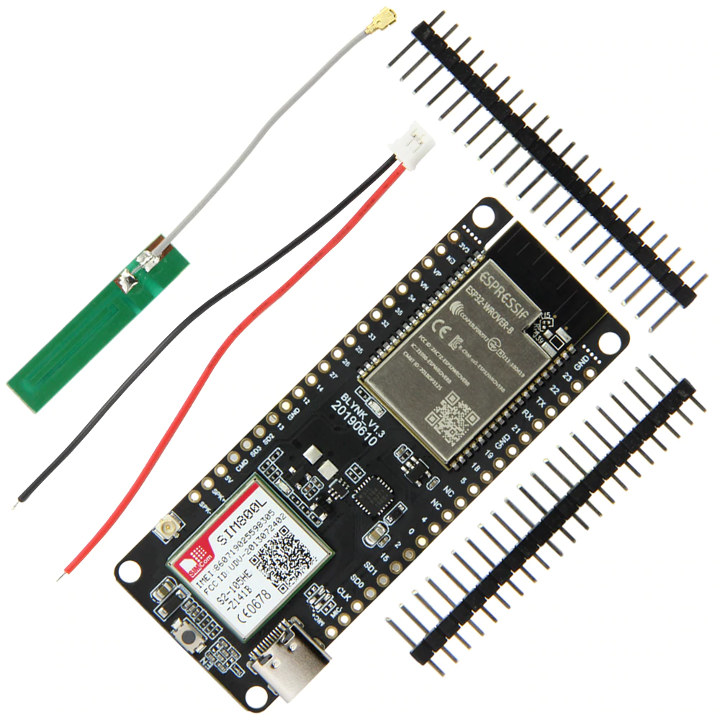LilyGo has launched several TTGO boards usually based on Espressif ESP8266 or ESP32 over the years. Here’s another that could be useful if 2G cellular networks have not sunset in your country: TTGO T-Call.
The new board combines ESP32 WiFi & Bluetooth WiSoC with SIMCom SIM800L GPRS module, and also happens to rely on a USB-C port for power and programming instead of the more common micro USB port on this type of hardware.
 TTGO T-Call board (BLINK_V1.3) specifications:
TTGO T-Call board (BLINK_V1.3) specifications:
- Wireless Module – ESP32-WROVER-B based on ESP32 dual core Xtensa processor @ 240MHz with 520kB SRAM on-chip, 4MB QSPI flash, 8MB PSRAM
- Connectivity –
- WiFi 4 802.11 b/g/n (2.4 GHz) up to 150 Mbps
- Bluetooth 4.2 Classic + LE
- Cellular – 2G GSM/GPRS via SIMcom SIM800L module + Nano SIM card slot
- USB – 1x USB-C for power and programming (via CP2104)
- Expansion – 2x 21-pin headers with UART, SPI, SDIO, I2C, PWM, I2S, IRGPIO, capacitor touch sensor, ADC, DAC
- Misc – Reset Button, on-board40MHz crystal oscillator
- Power Supply
- 5V/1A via USB-C port
- 2-pin JST header for 3.7V Lithium battery, support for 500mA charging current
- Operating Voltage – 2.7V-3.6V
- Power Consumption – About 70mA while active; sleep: about 300uA
- Dimensions – 78.8 x 28.9 x 8.1 mm
- Weight – 11.77 grams
- Temperature range – -40 ~ +85

There’s limited information about the board, and basically, all we got is this Github repo with a link to an Arduino sample, library to control Seeduino GPRS, as well as datasheets and AT commands set for SIM800. Checking out Seeeduino GPRS Wiki may help getting started with TTGO T-Call board.
The ESP32 GPRS board can be purchased now on Aliexpress for $14.36 plus shipping ($4.82 in my case). The board ships with wires for a battery, the headers, and a 9cm GPRS antenna. Again, you should check the local status/roadmap for 2G in your area to make sure the board will not be useful in a few months. I’ve been told 2G in Europe will keep working for many years since it’s required for the mandatory e-Call function in cars.
Via Time4EE on MeWe’s Development Boards & SBCs group

Jean-Luc started CNX Software in 2010 as a part-time endeavor, before quitting his job as a software engineering manager, and starting to write daily news, and reviews full time later in 2011.
Support CNX Software! Donate via cryptocurrencies, become a Patron on Patreon, or purchase goods on Amazon or Aliexpress






Now if it used the new ESP32 chip with native USB, I’d be VERY interested in this board!
why? just curious
GPRS? Isn’t that just about dead?
only if you got LTE Cat M1 coverage. you will get much worse batterylife with 3g or (“normal”) 4g, not to mention the modem prices…. Cat NB is a joke, no roaming and no handover.. so its a mobile network for stationary things, like your dishwasher..
It is dead in the US (2G GPRS)
It is simcom not ublox.
OK, that’s embarrassing. I must have seen too many U-blox modules. Fixed!
SIM800L is made by SIMCom, not U-Blox. U-Blox makes GPS modules, not GPRS.
my Sara G350 module in front of me strongly objects to your statement.
Her friend Sara U201 agrees. Lets not mention Sara R412m
seems will be a nice gateway for local wifi network of esp32-ed iot sensors e.g. on a high mountain peak, or forest, or lake, glacier
“support for 500mA charging current” , how does it work?
what is the best way to energize the whole module?
Great idea for a board, combines two very useful chips in a neat packet with excellent power control (the sim800L can be tricky with it’s momentary 2A spikes). However i am struggling getting the mic and speaker working. On a standalone sim800 it’s fairly easy, just hookup a little mike and speaker, same goes for the dev units. But I can’t get it to work on the TTGO Tcall. It looks like they tried to create the filtering circuits suggested in the sim800L data sheet on the board, but in doing so they actually broke the speaker and mic outputs.… Read more »